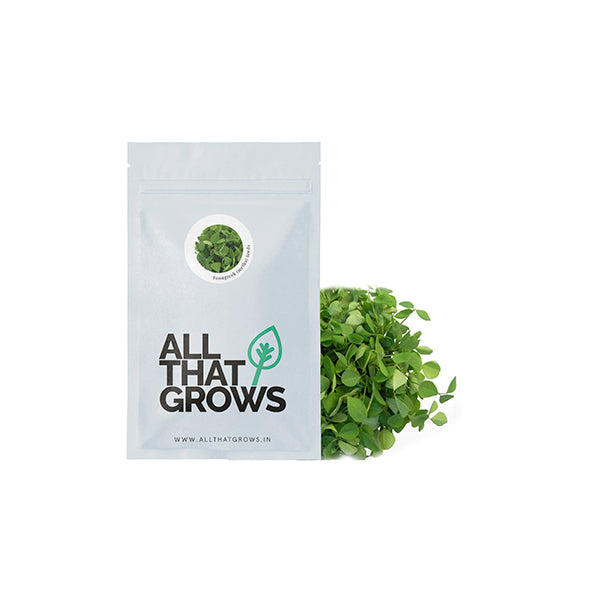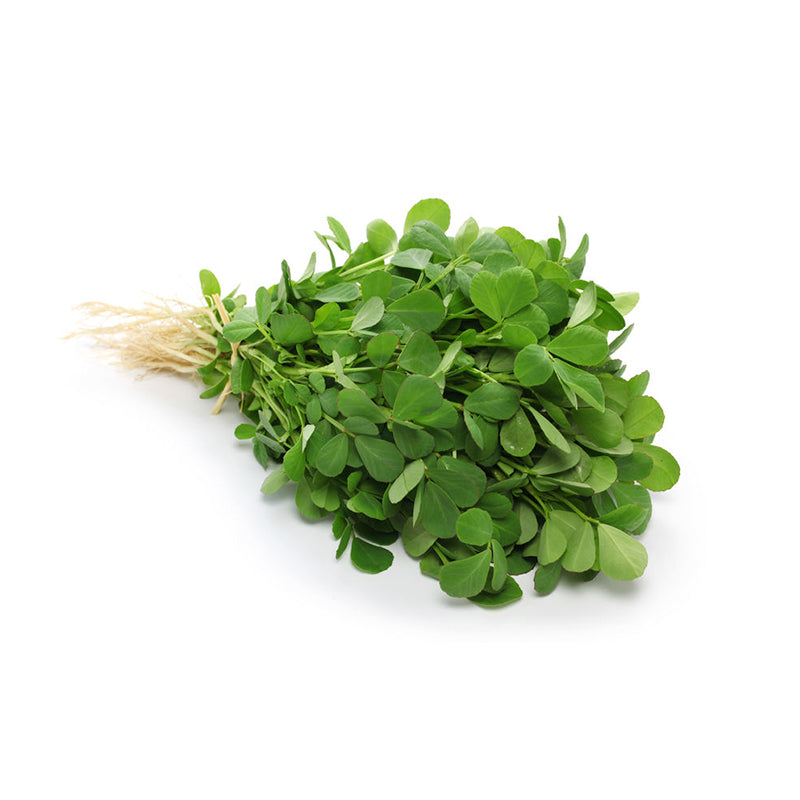



Fenugreek (Metha) Seeds
Grow this with
Seed Type : Non-Hybrid, Open Pollinated and Non-GMO
SOWING TIME : October to November
PLANT CHARACTER : Light green,lanceolate in shape
LEAF CHARACTER : Thick and well branched
FLOWER COLOR : Yellow
CUTTINGS : Multiple, heavy yielder
HARVEST: 30-35 days after 1st sowing
- SOWING
TIMESeptember - December
- Sowing
DistancePLANT TO PLANT - 9" LINE TO LINE - 6"
- Fruit
WeightN/A
- Fruit
ShapeN/A
- Days to
maturity30-35 Days
- Details
- How to sow
- Reviews
Cultivated in North Africa, the Middle East, Egypt, and India, Fenugreek has a long history as an ingredient in traditional medicine. The leaves are flat and spear-shaped, and radiate out from a central stem. Fenugreek is rich in calcium, phosphorus, iron nd Vitamin C. The leaf is highly beneficial for treating poor liver functions and dyspepsia. It helps in controlling blood sugar levels as galactomannan, a natural soluble fiber present in Fenugreek slows down the rate of sugar absorption into the blood. It also contains amino acid responsible for inducing the production of insulin. Fenugreek is beneficial in the case of high blood levels of certain fats including cholesterol and triglycerides. It also helps in reducing menstrual discomfort and prevents colon cancer.
Fenugreek is most widely used in Indian cuisine, though it is also found in North African and Middle Eastern dishes. While the leaves smell like caramel or maple syrup, when heated, their taste is rather bitter, like burnt sugar. The ground seeds (yellow) are often used in curry powder, spices blends, dry rubs, and tea blends. Fresh leaves can be added to salads and cooked dishes. Start out with a small amount—too much can cause a bitter taste.
Planting instructions
Sow seeds ¼ inches deep in a good potting mix or soil.
Leave 2 inches of space between each plant while sowing seeds. They'll sprout quickly and you'll see seedlings within 2 – 4 days
Growing Requirements
watering
Make sure that the soil is evenly moist. In case of excess water, make sure it does not stay and drains away quickly.
pests
The crop might show symptoms of discoloration of vine at soil line. Leaves may wilt and fall from plant. Small soft bodied insects on underside of leaves and/or stems of plant; usually green, yellow or white in colour, leave powdery spots on leaves which expand over time. The pests that attack this crop are Aphids, Powdery Mildew, Charcoal Rot, Root Rot.
soil
Fenugreek prefers neutral soil with pH level around 6 – 7. Loamy soils are best suited for its cultivation.
spot
An area with full sun, but partial shade or even filtered sunlight will also work.
temperature
Fenugreek grows well in warm and hot climate, when temperature ranges from 10 C to 32 C (50 to 90 F ).
how to harvest
The harvesting method will vary depending on whether you're trying to get leaves or seeds from your fenugreek plant.
For leaves, cut the plant at the stem a few centimeters above the soil.
For seeds, wait for the pods on the plant to turn yellow, signalling that they've fully ripened, and harvest the seeds before the pod pops open.

Customer Reviews
The productiveness of any seed we sell is subject to your local climatic conditions*, the sowing method you adopt, and your commitment to the planting process. We give no warranty, expressed or implied, and are in no way responsible for the produce.
Please note that all our seasonal recommendations/ sowing information is as per the local climatic conditions. *For more information on the optimum conditions required for growing seeds in your region, please contact us at, hello@allthatgrows.in or Whatsapp us at, +91 8544865077
Questions & Answers
Have a Question?
Be the first to ask a question about this.




Fenugreek (Metha) Seeds
Seed Type : Non-Hybrid, Open Pollinated and Non-GMO
SOWING TIME : October to November
PLANT CHARACTER : Light green,lanceolate in shape
LEAF CHARACTER : Thick and well branched
FLOWER COLOR : Yellow
CUTTINGS : Multiple, heavy yielder
HARVEST: 30-35 days after 1st sowing
Grow this with
Cultivated in North Africa, the Middle East, Egypt, and India, Fenugreek has a long history as an ingredient in traditional medicine. The leaves are flat and spear-shaped, and radiate out from a central stem. Fenugreek is rich in calcium, phosphorus, iron nd Vitamin C. The leaf is highly beneficial for treating poor liver functions and dyspepsia. It helps in controlling blood sugar levels as galactomannan, a natural soluble fiber present in Fenugreek slows down the rate of sugar absorption into the blood. It also contains amino acid responsible for inducing the production of insulin. Fenugreek is beneficial in the case of high blood levels of certain fats including cholesterol and triglycerides. It also helps in reducing menstrual discomfort and prevents colon cancer.
Fenugreek is most widely used in Indian cuisine, though it is also found in North African and Middle Eastern dishes. While the leaves smell like caramel or maple syrup, when heated, their taste is rather bitter, like burnt sugar. The ground seeds (yellow) are often used in curry powder, spices blends, dry rubs, and tea blends. Fresh leaves can be added to salads and cooked dishes. Start out with a small amount—too much can cause a bitter taste.
Seed Type : Non-Hybrid, Open Pollinated and Non-GMO
SOWING TIME : October to November
PLANT CHARACTER : Light green,lanceolate in shape
LEAF CHARACTER : Thick and well branched
FLOWER COLOR : Yellow
CUTTINGS : Multiple, heavy yielder
HARVEST: 30-35 days after 1st sowing
- SOWING
TIMESeptember - December
- Sowing
DistancePLANT TO PLANT - 9" LINE TO LINE - 6"
- Fruit
WeightN/A
- Fruit
ShapeN/A
- Days to
maturity30-35 Days
Planting instructions
Sow seeds ¼ inches deep in a good potting mix or soil.
Leave 2 inches of space between each plant while sowing seeds. They'll sprout quickly and you'll see seedlings within 2 – 4 days
Growing Requirements
watering
Make sure that the soil is evenly moist. In case of excess water, make sure it does not stay and drains away quickly.
pests
The crop might show symptoms of discoloration of vine at soil line. Leaves may wilt and fall from plant. Small soft bodied insects on underside of leaves and/or stems of plant; usually green, yellow or white in colour, leave powdery spots on leaves which expand over time. The pests that attack this crop are Aphids, Powdery Mildew, Charcoal Rot, Root Rot.
soil
Fenugreek prefers neutral soil with pH level around 6 – 7. Loamy soils are best suited for its cultivation.
spot
An area with full sun, but partial shade or even filtered sunlight will also work.
temperature
Fenugreek grows well in warm and hot climate, when temperature ranges from 10 C to 32 C (50 to 90 F ).
how to harvest
The harvesting method will vary depending on whether you're trying to get leaves or seeds from your fenugreek plant.
For leaves, cut the plant at the stem a few centimeters above the soil.
For seeds, wait for the pods on the plant to turn yellow, signalling that they've fully ripened, and harvest the seeds before the pod pops open.



 Sign In
Sign In








